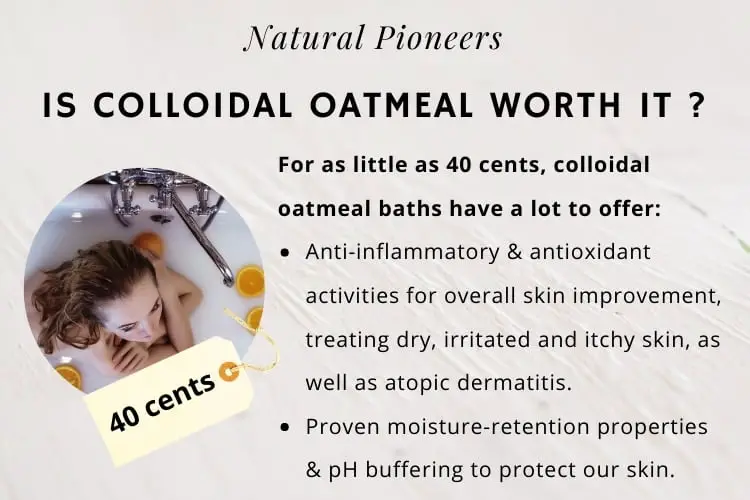
Colloidal oatmeal has a lot to offer. Let’s find out what colloidal oatmeal is, why it’s a worthy addition to our skin care routine, and how to make colloidal oatmeal at home.
1. What Is Colloidal Oatmeal
Colloidal oatmeal is a centuries-old treatment for a variety of skin conditions, including skin rashes, erythema, burns, itch, and eczema. Colloidal is a term defining the tiny size of the oat particles. Colloidal oatmeal has particles ranging between 1 and 1000 nanometers in diameter, much smaller than can be achieved in a home setting.
Colloidal oatmeal is processed from whole oats, including the bran, whereas store-bought oat flour is made from oats with bran removed and has a much larger particle size.
Colloidal oatmeal is commonly used in bath powders, cleansers, and moisturizers. It contains a broad spectrum of components that provide a number of skin care benefits. [1]
Composition and beneficial properties of colloidal oatmeal: [2]
- Proteins: Help maintain the skin barrier
- Polysaccharides and lipids: Replenish the skin barrier
- Vitamin E: Antioxidant
- Saponins: Cleansing
- Enzymes: Antioxidants
Studies find colloidal oatmeal improves the overall skin condition with its soothing, moisturizing and protective properties. Moreover, colloidal oatmeal is used in the treatment of several skin conditions including eczema.
Conclusion: Colloidal oatmeal is made by grinding whole oats into a fine powder, with particles much smaller than oat flour. Colloidal oatmeal is available in bath powders, shampoos, shaving gels, and moisturizing creams. Studies confirm its cleansing, protecting, soothing, and skin improving properties.
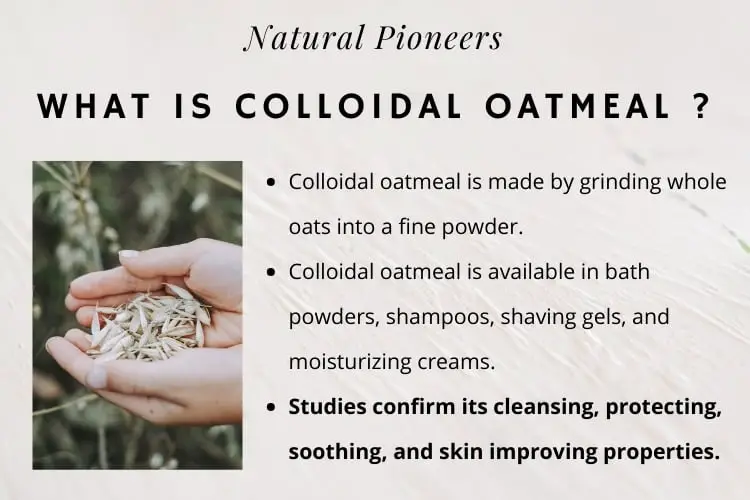
2. Benefits Of Colloidal Oatmeal
Colloidal oatmeal is used in products like bath powders, cleansers, and moisturizers. If you’re looking to treat a certain condition, make sure you understand what kind of product a certain study has used (see below) and speak with your doctor first.
Benefits Of Colloidal Oatmeal:
- Soothing: According to the US Food and Drug Administration (FDA), colloidal oatmeal has a soothing effect that alleviates itching and irritation in eczema. Leave-on emollients with colloidal oatmeal seem to be most beneficial in the treatment of eczema [3]; [4]
- Anti-inflammatory: A study using colloidal oatmeal lotion found the anti-inflammatory activities to be the reason for its effectiveness in treating of dry, irritated skin [5]
- Antioxidant activity: Colloidal oatmeal shows antioxidant activities that benefit dry, irritated skin [6]
- Helps with eczema: Colloidal oatmeal has been shown beneficial in the treatment of atopic dermatitis and resulted in significantly improved symptoms and severity of eczema [7]; [8]
- Itch-relief: A study on colloidal oatmeal cleanser and colloidal oatmeal cream showed significant improvement in itching, dryness, roughness, and severity after 4 weeks of use [9]
- Protects our skin: Colloidal oatmeal forms a protective film on the skin. Colloidal oatmeal serves as a pH buffer helping to maintain a healthy skin surface pH [10]; [11]
- Moisturizer: With its moisture-retention properties, colloidal oatmeal keeps our skin smooth [12]
- Better skin: After 4 weeks of using a colloidal oatmeal regimen, including colloidal oatmeal cleanser and colloidal oatmeal cream, studies demonstrated an overall improvement in skin condition [13]; [14]
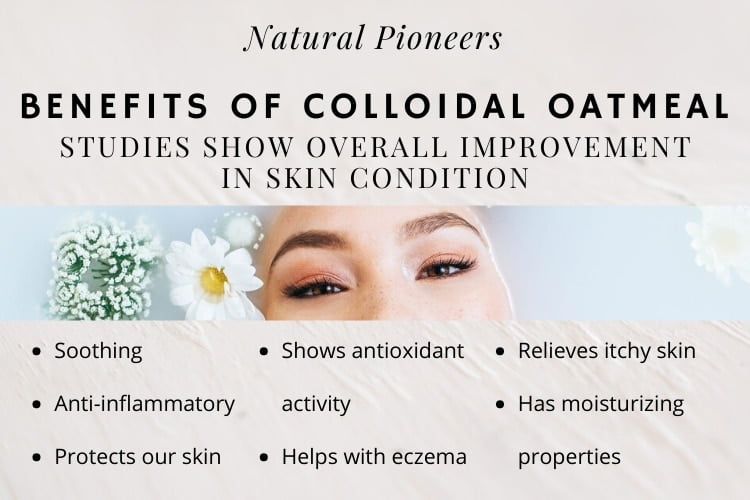
3. Homemade Colloidal Oatmeal Recipe
Before making your own colloidal oatmeal at home, please be aware that you might not be able to achieve the same quality of colloidal oatmeal that has been used in studies. Professionally prepared colloidal oatmeal has particles ranging between 1 and 1000 nanometers in diameter, much smaller than can be achieved in a home setting.
However, it is possible to grind oats to a point where they dissolve in water and turn it into a milky color with a silky feel on your skin. Let’s see how it’s done.
Simple Steps To Make Colloidal Oatmeal At Home:
Equipment:
- Blender, food processor, or coffee grinder.
- Whole grain rolled oats (old-fashioned, quick or instant oats)
Preparation:
- For one bath, pour about 1 cup (237 grams) of rolled oats into a food processor, coffee grinder, or blender. You may use old-fashioned oats, quick oats or instant oats. We don’t recommend oat flour, as the bran has usually been removed.
- Pulse the oats until it resembles a fine, off-white powder.
- Test if your powder is ground finely enough: Mix 1 tablespoon (15 grams) into a pint (16 ounces or 473 mL) of water and observe if it fully dissolves to turn the water milky white. If not, simply grind the oatmeal further. Repeat this process until you’ve reached the desired consistency.
- Start running warm water into a clean bathtub. Be sure it’s not too hot as hot water can aggravate inflamed skin and draw moisture from your skin.
- Add about 1 cup (237 grams) of ground oat powder into lukewarm water under the running tap and mix with your hand until completely dissolved.
- Once the water has reached the proper level, the water should be milky and feel silky on your skin. For ideal results, soak in it twice a day for 10–15 minutes.
Oatmeal can make your bathtub slippery, so take extra caution when you or your child step out of the tub.
Looking for more natural bath additives?
Read more in our article about: Natural Bath Additives
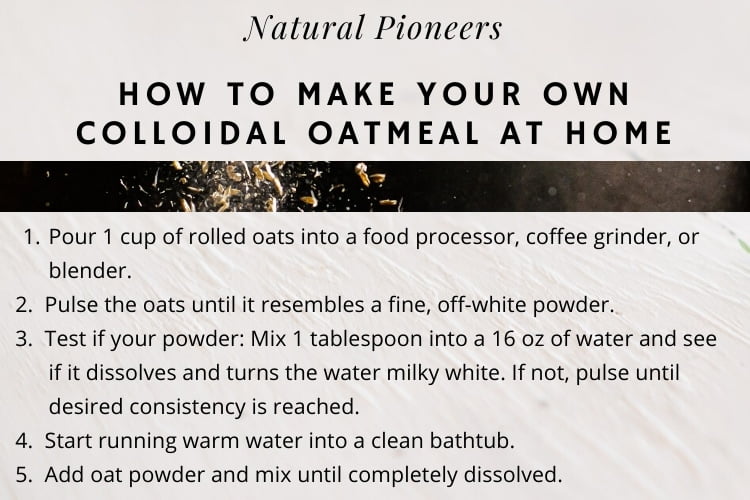
4. Colloidal Oatmeal | Frequently Asked Questions
Do you rinse off after an oatmeal bath?
There is no need to rinse off your body after a colloidal oatmeal bath. After the bath, gently pat yourself dry so your skin still feels damp. According to studies, applying colloidal oatmeal lotion or cream after your bath will further benefit itchy, dry and irritated skin. [15]; [16]
Should I shower after a bath in colloidal oatmeal?
There is no need to shower after a colloidal oatmeal bath. After the bath, gently pat yourself dry so your skin still feels damp. According to studies, applying colloidal oatmeal lotion or cream after your bath will further benefit itchy, dry and irritated skin. [17]; [18]
Will colloidal oatmeal clog my drain?
If the appropriate amount of 1 cup per standard bathtub is used, the fine powder of colloidal oatmeal won’t clog your drain. Make sure to rinse any residue off the sides of your tub after taking your bath.
Does colloidal oatmeal clog my pores?
Colloidal oatmeal won’t clog your pores or cause acne. In fact, the opposite is true: the anti-inflammatory activities of colloidal oatmeal have a soothing effect on itchy, dry, and irritated skin. [19]
Is colloidal oatmeal good for acne?
Colloidal oatmeal may be beneficial when treating acne. The anti-inflammatory activities of colloidal oatmeal have a soothing effect on itchy, dry, and irritated skin. According to studies, applying colloidal oatmeal lotion or cream after your bath will further benefit itchy, dry and irritated skin. [20]; [21]
Is colloidal oatmeal good for skin?
Hot baths with colloidal oatmeal show anti-inflammatory and antioxidant activities that are beneficial for overall skin improvement, treating dry, irritated and itchy skin, as well as atopic dermatitis. Colloidal oatmeal baths have proven moisture-retention properties and serve as a pH buffer helping to maintain skin surface pH. [22]; [23]; [24]; [25]
Can I use other flour instead of colloidal oatmeal?
Health benefits of colloidal oatmeal have been tested using only colloidal oatmeal products and no other flour or grain types. When trying to achieve similar outcomes for your skin, we recommend using the original colloidal oatmeal with particles sizes ranging between 1 and 1000 nanometers in diameter.
Is there an alternative to colloidal oatmeal?
For eczema and damaged skin, studies on rice starch led to a 20% improvement on the healing capacity of damaged skin. About 1/2 cup of rice starch powder per bath tub has shown to be effective for skin repair. [26]; [27]
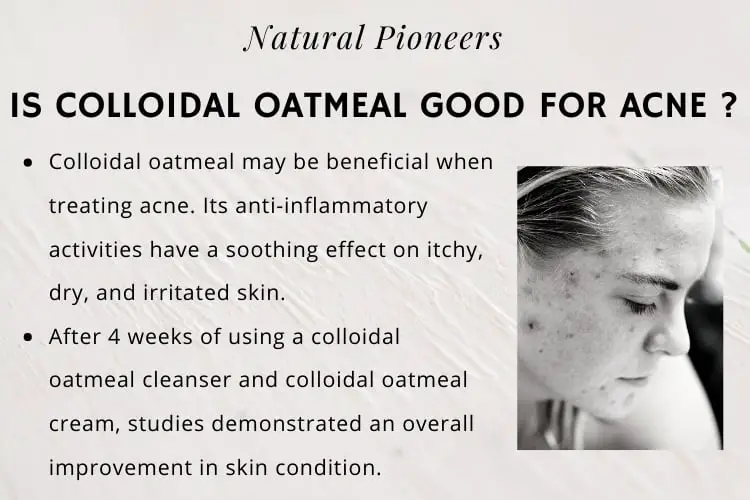
5. Price Of Colloidal Oatmeal Products
Making your own colloidal oatmeal is more of a time commitment than buying some at the store or conveniently ordering online. Since all health beneficial studies on oatmeal baths have been done with only 100% colloidal oatmeal, this is what we are looking for.
To be clear, there are hundreds of colloidal oatmeal products available – all, with a long list of ingredients that can potentially do our skin more harm than good.
Let’s look at prices: When we made our own colloidal oatmeal, we’ve used Simple Truth Organic Quick Oats. 1 cup per standard bath size costs about 40 cents.
Colloidal oatmeal at the drugstore costs about 1 USD per package and bath. When you go to CVS, you can find these kinds of bath packets.
Conclusion: Homemade colloidal oatmeal costs around 40 cents per bath. Available non-organic colloidal oatmeal at drugstores costs around 1 USD per bath.
